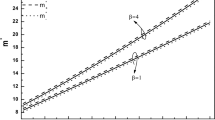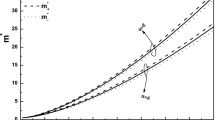Abstract
Using the linear combination operator method and variational technique improved by Tokuda, we obtain the expression of the effective mass of a strong coupled polaron in an anisotropic quantum dot. Due to the spin–orbit interaction, the effective mass of the polaron splits into two branches. The dependence of effective mass on temperature, electron–phonon coupling strength, transverse and longitudinal confinement lengths, and velocity is discussed by numerical calculation. The theoretical results indicate that the effective mass of the polaron is an increasing function of temperature and electron–phonon coupling strength, but a decreasing function of transverse confinement length, longitudinal confinement length, and velocity. The absolute value of spin splitting effective mass increases with the increase of temperature and spin–orbit coupling parameter, but decreases with the increase of transverse confinement length, longitudinal confinement length, and velocity. Due to the heavy hole characteristic, the spin splitting effective mass is negative.








Similar content being viewed by others
References
E.I. Rashba, A.I.L. Efros, Phys. Rev. Lett. 91, 126405 (2003)
S.A. Wolf, D.D. Awschalom, R.A. Buhrman et al., Science 294, 1488 (2001)
S.-P. Shan, S.-H. Chen, J. Low Temp. Phys. 197, 379 (2019)
J. Liu, J.-L. Xiao, S.-F. Huo, Z.-Y. Chen, Commun. Theor. Phys.. Theor. Phys. 48, 930 (2007)
S.-P. Shan, Y.-L. Li, J. Low Temp. Phys. 177, 315 (2014)
L. Hong, J. Ge, S. Shuang, D.-K. Liu, Acta. Phys. Sin. 71, 016301 (2022)
W. Xuan, N. Yang, J. Luo, R. Wang et al., Appl. Phys. A 129, 588 (2023)
S.-P. Shan, S.-H. Chen, Pramana-J. Phys. 94, 15 (2020)
A.M. Babayev, Ş Çakmaktepe, D.T. Altug, J. Opto. Biom. Mate. 1, 37 (2009)
E. Lipparini, M. Barranco, F. Malet, M. Pi, Phys. Rev. B 74, 115303 (2006)
Z.-J. Qiu, Y.-S. Gui, X.-Z. Shu, N. Dai et al., Acta. Phys. Sin. 53, 1186 (2004)
S.-P. Shan, S.-H. Chen, J.-L. Xiao, J. Low Temp. Phys. 175, 523 (2014)
Author information
Authors and Affiliations
Contributions
Shu-Ping Shan, Wei-Dong Zou, Ren-Zhong Zhuang, and Hui-Ye Qiu wrote the main manuscript text and Rong-Xin Chen prepared figures 1-8. All authors reviewed the manuscript.
Corresponding author
Ethics declarations
Competing interests
The authors declare no competing interests.
Additional information
Publisher's Note
Springer Nature remains neutral with regard to jurisdictional claims in published maps and institutional affiliations.
Rights and permissions
Springer Nature or its licensor (e.g. a society or other partner) holds exclusive rights to this article under a publishing agreement with the author(s) or other rightsholder(s); author self-archiving of the accepted manuscript version of this article is solely governed by the terms of such publishing agreement and applicable law.
About this article
Cite this article
Shan, SP., Zou, WD., Zhuang, RZ. et al. Influence of Temperature and Spin–Orbit Interaction on the Effective Mass of Polaron in an Anisotropic Quantum Dot. J Low Temp Phys 214, 21–31 (2024). https://doi.org/10.1007/s10909-023-03010-z
Received:
Accepted:
Published:
Issue Date:
DOI: https://doi.org/10.1007/s10909-023-03010-z




